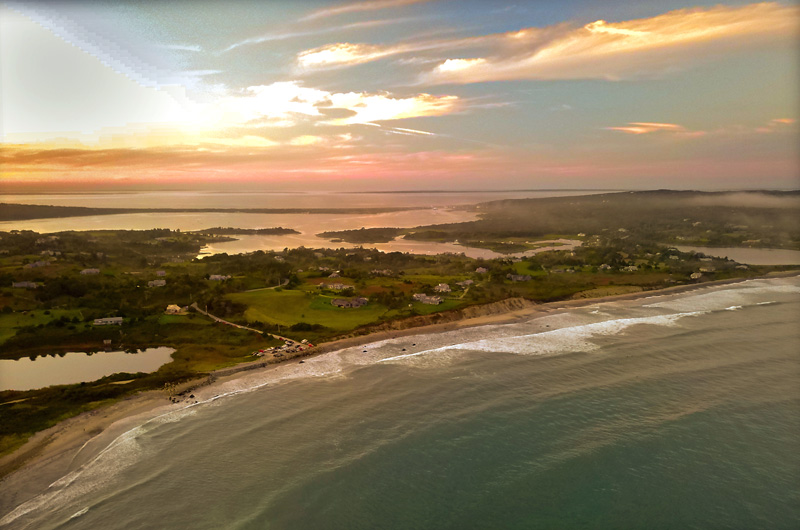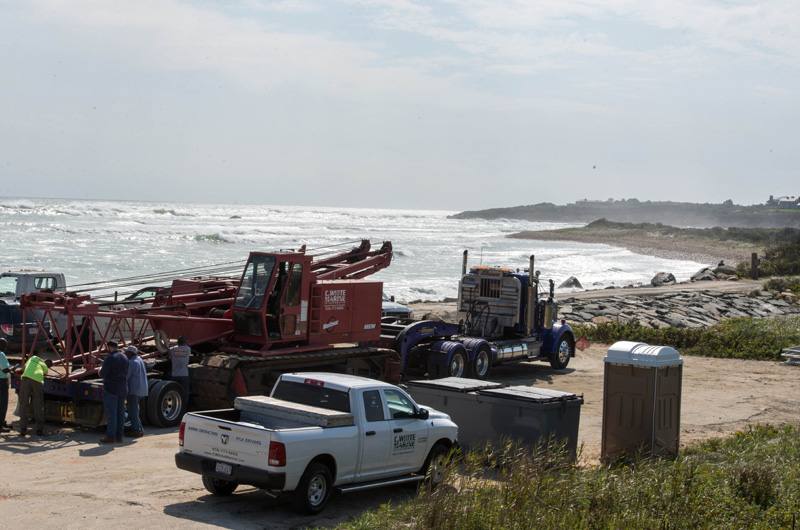Five years after Hurricane Sandy ravaged Squibnocket Beach, and more than two years after town voters agreed to back a complicated public/private partnership to provide access to Squibnocket Farm, work began this week on the private portion of the project.
A 300-foot raised causeway will be built across marshland and beachfront to provide stable access to the farm, a private enclave of about 13 homes on a vast expanse of nearly 1,000 acres of rolling moors and beach.
The causeway will replace the road that sits 10 feet above sea level and runs across the pebbly beachfront to the homes. The road washes out frequently during heavy storms. The area also includes a public town beach, marshland and a corner of Squibnocket Pond.
On Monday, Boston contractors C. White Marine moved a large crane onto the beachfront and began preliminary site work for driving support piles into the pristine marshland between the ocean and pond. The crane towered over the seascape, the sound of its idling diesel engine competing with the sound of waves crashing onto the severely eroded beach. Chain link fencing has gone up around the job site, marking off nearly half the damaged parking lot. Inside the fence are a steel storage trailer, a dumpster and a portable toilet.
Despite several town votes in support of the project, it has deeply divided some residents and property owners over several years of contentious public meetings and court action.
“I’m sorry that there has been so much acrimony around this project,” said Warren Spector, president of the Squibnocket Farm Homeowners Association. “I truly hope that when it’s finished and has time to age, that everyone comes to appreciate that we’ve done something thoughtful and attractive.”
Mr. Spector said plans call for the new causeway to be complete by late spring.
“I’m happy that it’s finally started,” he said. “I’m happy that we’ve passed all the regulatory hurdles, and all the legal hurdles, and finally are able to get the project underway.”
The homeowner association will pay the entire cost of the causeway. Mr. Spector declined to state the amount.
In a related move, last week the homeowner association bought a roughly four-acre piece of beachfront from the Vineyard Open Land Foundation, the group that developed the former Hornblower property into Squibnocket Farm in the 1990s. The purchase price was $500,000. The Squibnocket homeowners will now lease the property, which includes about 1,250 feet of beachfront, to the town to significantly extend the public beach holdings on the western end. The 99-year lease has been signed, Mr. Spector said.
In a 2014 presentation to town meeting voters, representatives of Squibnocket Farm outlined the design features of the new causeway to provide vehicle access to their homes. The straight, raised roadway will be about 300 feet long, sitting on steel pilings driven into the marsh. It would begin a short way up the hill from the current parking lot, crossing the expanse of marsh very near the shore of Squibnocket Pond, and ending just before the electronic gate leading to Squibnocket Farm.
The bottom of the causeway will be 11 feet above sea level, while the road surface will be 13 feet above the ground. A railing would extend four feet above the driving surface on both sides.

The design calls for a roadway driving surface 18.5 feet wide.
It is designed to carry trucks up to 40 tons and withstand the force of floods and hurricanes.
Chilmark selectmen are taking a mostly hands-off approach to the private part of the project, though they said they are pleased to see construction begin.
“The town project, which is the parking lot creation, the removal of the revetment, cannot happen until the causeway and access is completed,” said selectman Jim Malkin this week. “From the town’s point of view, we’re waiting on their project. Squibnocket Farm really has to have their access before we can do much of anything.”
Selectmen plan to put out a request for bids for the town part of the project on Friday. The town plans to remove the boulder revetment, relocate the parking lot and rebuild dunes to allow the beach to revert to a more natural state.
“We need to point out that the committee on Squibnocket came out with a recommendation that was voted at town meeting, and that’s the plan we’ve been moving forward with,” said William Rossi, chairman of the board of selectmen.
“The work has started and we expect it to be a beautiful job that will be finished before the summer season,” added selectman Warren Doty. “We expect to be able to remove that revetment and build a new parking lot all before next summer.”
The cost of the town portion of the project is estimated at $267,400.
Meanwhile, a neighbor group led by Blacksmith Valley resident Doug Liman has been attempting to block the project in court, to no avail. Last month the Massachusetts Land Court dismissed a complaint that sought to compel building inspector Leonard Jason Jr. to issue a building permit for the project. Mr. Jason has said that a building permit is not required under town bylaws for bridges and causeways. The land court judge agreed.
The complaint was dismissed with prejudice, which means the litigants are barred from returning to the land court.
Chilmark town counsel Ronald Rappaport said this week that Mr. Liman and David Stork, another property owner, have filed notice that they intend to appeal the ruling to the Massachusetts Court of Appeals.
Mr. Rappaport said he sees no merit in the appeal, and at any rate it will not halt work on the project.
Mr. Liman could not be reached for comment.
Thomas Bena, a Chilmark resident and outspoken opponent of the project, said he hears from a surprising number of people who oppose the plans but are reluctant to step into the public fray.
“It was amazing to see how many people wished they had gotten involved earlier, but didn’t really understand the whole project,” he said. “If a bridge was what was decided after a true public process, where we had all the ideas on the table and we vetted them all, I would not be fighting this thing. This was a sham, this was not a public process. From day one when their lawyer said my clients will only settle for a bridge. That’s basically what happened. Our town officials made things happen, including creating a new bylaw, that would allow one of the biggest bridges on Martha’s Vineyard to be built.”








Comments (6)
Comments
Comment policy »